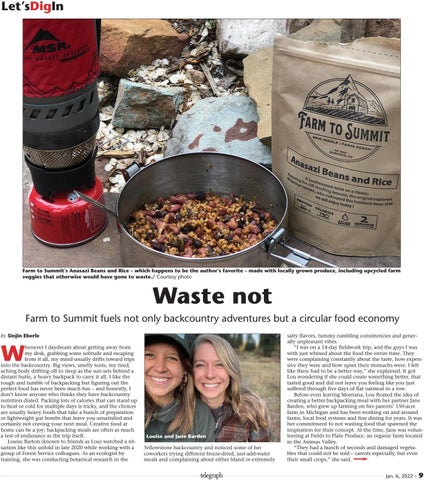Let’sDigIn
Farm to Summit’s Anasazi Beans and Rice – which happens to be the author’s favorite – made with locally grown produce, including upcycled farm veggies that otherwise would have gone to waste./ Courtesy photo
Waste not Farm to Summit fuels not only backcountry adventures but a circular food economy by Sinjin Eberle
W
henever I daydream about getting away from my desk, grabbing some solitude and escaping from it all, my mind usually drifts toward trips into the backcountry. Big views, smelly tents, my tired, aching body drifting off to sleep as the sun sets behind a distant butte, a heavy backpack to carry it all. I like the rough and tumble of backpacking but figuring out the perfect food has never been much fun – and honestly, I don’t know anyone who thinks they have backcountry nutrition dialed. Packing lots of calories that can stand up to heat or cold for multiple days is tricky, and the choices are usually heavy foods that take a bunch of preparation or lightweight gut bombs that leave you unsatisfied and certainly not craving your next meal. Creative food at home can be a joy; backpacking meals are often as much a test of endurance as the trip itself. Louise Barton (known to friends as Lou) watched a situation like this unfold in late 2020 while working with a group of Forest Service colleagues. As an ecologist by training, she was conducting botanical research in the
Louise and Jane Barden Yellowstone backcountry and noticed some of her coworkers trying different freeze-dried, just-add-water meals and complaining about either bland or extremely
telegraph
salty flavors, tummy rumbling consistencies and generally unpleasant vibes. “I was on a 14-day fieldwork trip, and the guys I was with just whined about the food the entire time. They were complaining constantly about the taste, how expensive they were and how upset their stomachs were. I felt like there had to be a better way,” she explained. It got Lou wondering if she could create something better, that tasted good and did not leave you feeling like you just suffered through five days of flat oatmeal in a row. Before even leaving Montana, Lou floated the idea of creating a better backpacking meal with her partner Jane Barden, who grew up farming on her parents’ 150-acre farm in Michigan and has been working on and around farms, local food systems and fine dining for years. It was her commitment to not wasting food that spawned the inspiration for their concept. At the time, Jane was volunteering at Fields to Plate Produce, an organic farm located in the Animas Valley. “They had a bunch of seconds and damaged vegetables that could not be sold – carrots especially, but even their small crops,” she said. Jan. 6, 2022 n
9





